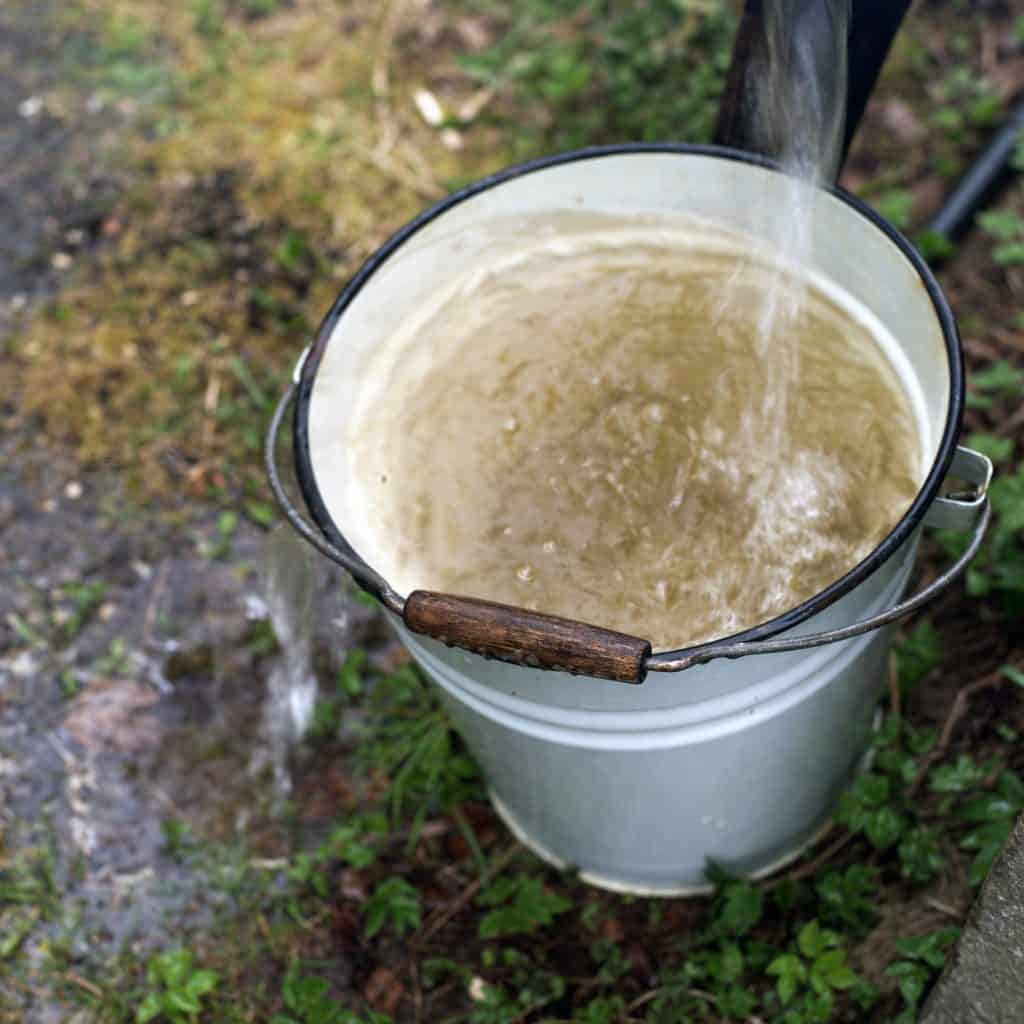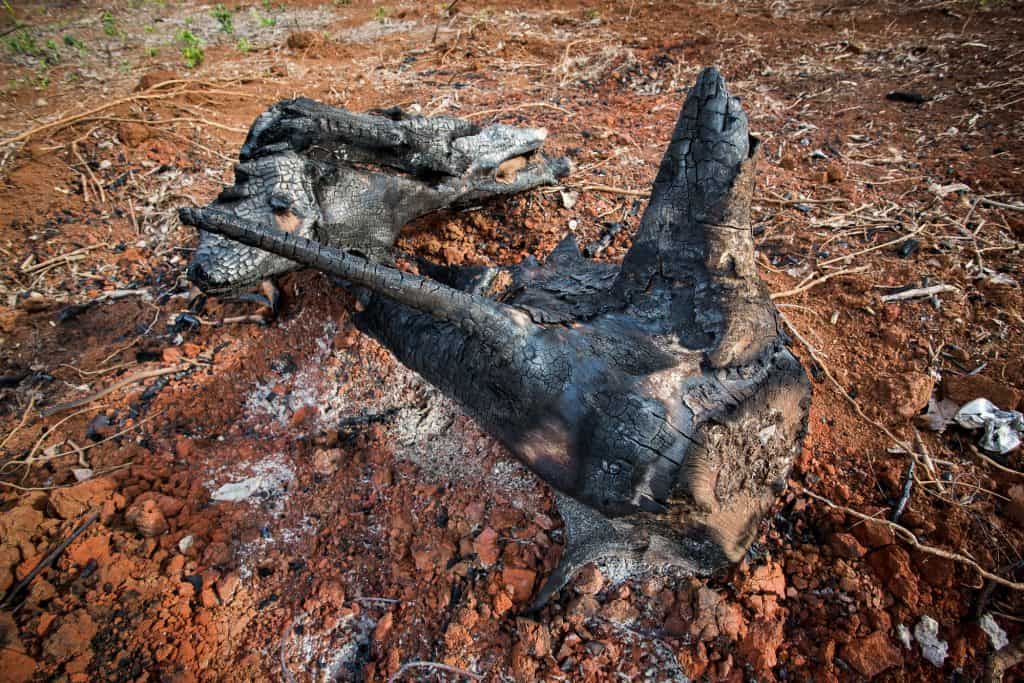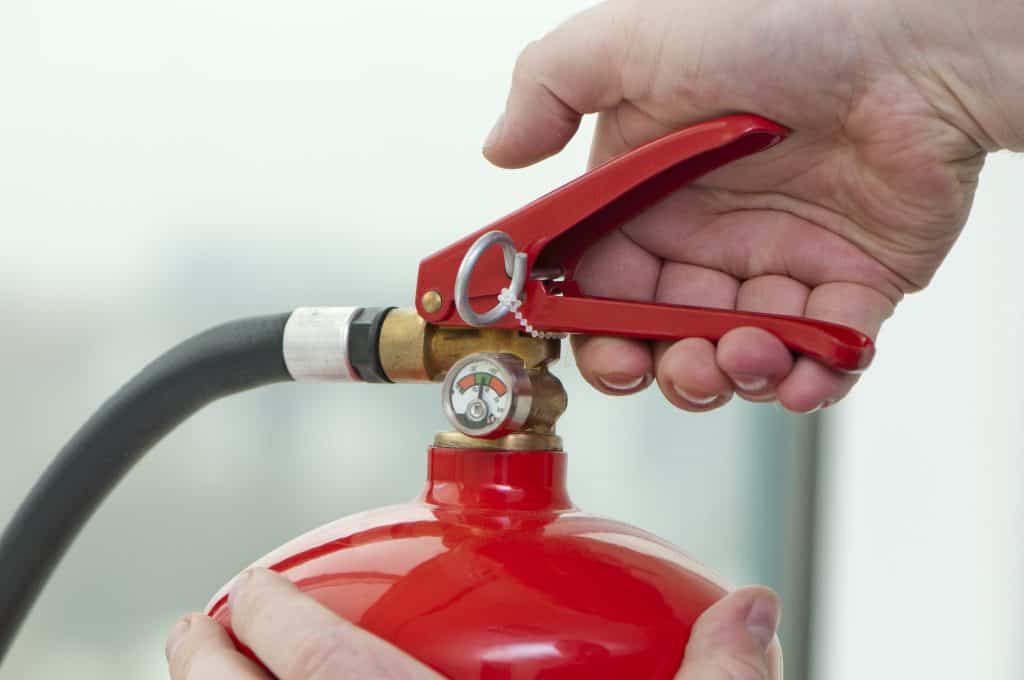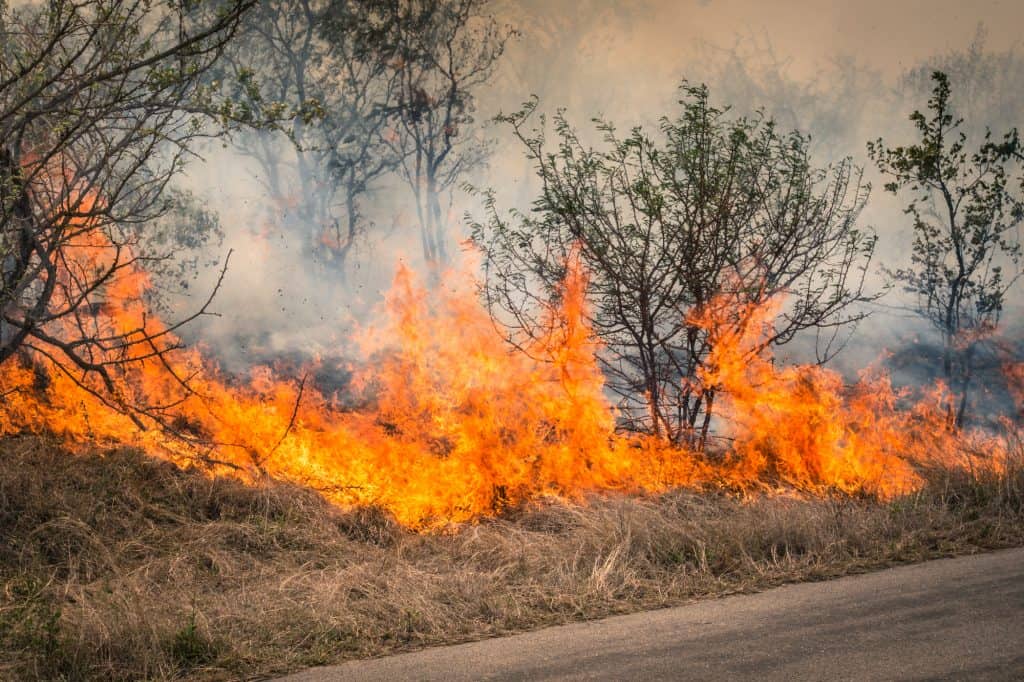Are you unsure how long it takes your fire to die down before it’s okay to go inside and hit the hay? Or, are you waiting to pull out of your campsite, but the embers are still glowing?
No matter your reason, it is essential to learn about different ways to put out a pit fire.
Some different ways to put out a fire pit fire include dousing it in water, mixing in dirt or sand, covering it with a snuffer, using a fire extinguisher, or disconnecting the fuel if it’s gas-powered. Before you leave, make sure there are no fallen embers, and the ash is cool to the touch.
Let’s cut to the chase.
If you’re uncertain that your fire is out, then it probably isn’t; don’t take a chance! Instead, follow this handy guide to learn more about ways to extinguish your pit fire and pick up some other fire safety tips on the way.
What Is a Fire Pit?
A fire pit is merely a fire in a pit dug in the ground or a more formal enclosure. One of these structures can be made of brick, steel, or other metals. Even if a pit fire is maintained within one of these structures, it is still much more open than one in a fireplace.
Fire pits are very common. If you’ve ever been to a campsite, you’ve seen them before. Since these structures are generally cheap, easy to use, and safe (when demonstrating proper fire behaviors), they’re a popular choice for many.
Gas Powered Fire Pit
Notably, gas-powered fire pits are also available on the market, but you can easily extinguish them with the click of a button. Fire pits also make a fantastic addition to the backyard ambiance.

Wood Burning Fire Pit
With a wood-burning fireplace, only one side of the structure is open, and they are much larger entities. An especially distinct separation between these two is that a fireplace sends smoke up through a chimney so exhaust can escape at a higher point.
Pit fires also differ from bonfires. While fire pits are contained in the ground or by a bowl, they’re fairly easy to control so long as you pay attention to them.
On the other hand, bonfires are significantly larger in size, emit much more heat, and are less controlled. Due to their size, bonfires require a greater plot of land in an open area. As such, they can spread quite easily if they get out of hand.
All three of these fire types and vessels can be extinguished the same way since they are all burning the same materials. You may need to take a different route to put out accidental fires like those born from electrical or grease sources.
Are Pit Fires Safe?
Generally speaking, pit fires are safe. However, like anything, there are certain risks you need to take into account before deciding that it’s a good idea to light one up.
- Check the fire danger rating. If you’ve been having some dry-weather days lately, there’s a much higher chance that vegetation will unexpectedly ignite. Before lighting a flame, check the current fire danger rating in your area with the Wildland Fire Assessment System’s handy map. The higher it is, the riskier your fire is.
- Consider the safety of the fire pit itself. Do-it-yourself fire pits are pretty common, but was yours made correctly? If this is your first time using it, demonstrate even more caution. Determine the kind of material used to make the fire pit, research it, and look closely at how it was constructed. If you’re skeptical of its safety, it’s best to skip the fire or at least have a hose ready to go.
- Factor in the wind. On a windy day, a breeze can transport embers across the site. This can be a significant fire safety threat, especially if your fire danger rating is on the higher end of the spectrum. The question is: how windy is too windy? Well, if you can see trees and debris flowing in the wind, it’s too risky to have a fire.
- Keep kids and animals away from the fire. Anyone who doesn’t understand a fire’s risk needs to keep their distance from the flames. In fact, everyone should be mindful of their proximity. However, young children and animals are more at risk since they may not understand the dangers of fires. Think on their behalf and make sure they stay away.
- Be careful if alcohol is involved. Not only are inebriated adults more likely to engage in reckless behavior near an open fire, but alcohol itself is also flammable. An accidental pour into the fire can cause flames larger than you bargained for.
How to Determine When a Pit Fire Is Out
It’s not enough for a fire to no longer be flaming — you must double-check that the fire has actually been extinguished before it is safe to leave.
Some may be shocked to hear this, but the truest way to determine if a fire has been fully put out is to touch the coals with your hands. If they’re too hot to touch, then they’re too hot to abandon.
As we’ll teach you about shortly, it’s absolutely necessary that you ensure all coals have cooled, all embers are extinguished, and no burning debris has fallen outside of the pit.
Active flames may be hotter than coals, but that doesn’t mean they aren’t dangerous.
This is why it’s necessary to turn over the ashes in a fire pit — you need to be sure that all of them are totally out. This may be tedious, but it’s an essential aspect of fire safety.
Douse Fire in Water

The most convenient way to put out a pit fire is by dumping water on it. It’s easy to do, and there’s a good chance you’ll be lighting your fire near some sort of water source. However, did you know that many people actually don’t correctly follow this method?
Contrary to popular belief, safe fire extinguishing involves more than simply pouring a bucket of water on the flame. Here’s how to properly douse a fire in water:
- Let the fire naturally die out if you can. About an hour before you need it extinguished, stop adding wood to the fire. It’s much easier to put the fire out if you take this step. Of course, there are instances where this is not always feasible. Sometimes, you just don’t have the time to fully let the flames burn off. We get that! Still, it’ll make your life a lot easier if you can plan for this.
- Use a shovel or stick to spread out the leftover coals. The more surface area you can cover with water on the remaining wood and coals, the faster they will cool down. Separate them to the best of your ability, so they don’t pass their residual heat on to neighboring embers. Keep a close eye on red-hot pieces and bigger wood logs as they can carry significant heat inside.
- Bring on the water. Now, it’s time to take the step that most people start with: pouring water on the pit. Since the fire has already burnt out, you might wonder why this is necessary. Though the flames may be gone, those embers are still flammable and full of heart. Carefully cover everything with water, but keep your distance and beware of hot rising steam. Continue to douse the fire until you can’t hear any more sizzling sounds.
- Stir up the ashes with your shovel or stick. Embers can easily hide out of reach, so you must take a moment to turn the ashes over, exposing any that may have gone undetected. If you’re unsure that they’ve all been extinguished, pour more water into the pit. It’s always better to be safe than sorry when it comes to fires.
- Sweep the area for fallen, lingering embers. Believe it or not, the tiny embers that crackle out of your fire pit can become forest fire ammunition. To ensure the wind hasn’t spread any ignited leaves or debris, thoroughly check the entire area (yes, the entire area) before you leave. Unwanted fires are never good — especially when they’re traced back to you!
- Check the pit’s temperature. The final step to take before walking away from your pit fire is assessing the temperature. Stick your hand in (yes, really) to see if it has fully cooled down. If it’s too hot for your hand, it’s too not to leave.
Cover Fire With Dirt

No water? No problem! While a liquid blast is the most conventional way to extinguish a pit fire, it’s certainly not the only way. Maybe your hose is broken, or you’re backcountry camping with no lakes to be seen. It’s all good.
To put your fire out with dirt, you’ll use the same technique you would with water. Let your flames naturally burn out (if possible), spread out any remaining wood and coals, then add dirt on top of the embers and mix it around until they’re fully out.
As always, check the surrounding area for fiery debris and conduct a temperature check before leaving.
If dirt isn’t readily available, you can also substitute sand.
Use a Fire Extinguisher
Using an extinguisher might not be at the forefront of your brain when thinking about putting out a pit fire, but a fire is a fire.
This method will definitely work, but it’s probably something you want to get in the habit of doing.
Fire extinguishers are meant for emergency use. Therefore, using one to put out a recreational fire is not the smartest plan. After all, who knows what could happen between now and the time it takes you to replace this extinguisher?

On top of that, fire extinguishers are expensive to replace. Plus, extended exposure to or inhalation of fire extinguisher spray can pose health concerns.
Additionally, depending on where you are, it may not be practical to carry one around anyway, so it’s important to learn other methods as well.
How to Use
However, most people have never used a fire extinguisher before, so this can add an extra layer of stress and anxiety in the case of an accidental fire. Intentionally using one to put out a recreational fire may be a good learning experience, but try not to make it a habit.
Use the acronym PASS to remember the proper fire extinguishing method:
- P: Pull out the safety pin to break the seal.
- A: Aim the nozzle at the base of the fire.
- S: Squeeze the extinguisher’s handle to release the spray.
- S: Sweep from side to side, covering the entire base of the fire until fully extinguished.
Memorize this acronym, and you’ll be set for emergency fire extinguisher use.
Smother the Flame With a Snuffer
For a fire to burn, the flames require oxygen. If this source is depleted, it has no choice but to burn out. As such, snuffer covers are great tools to quickly extinguish your pit fire.
These are essentially just metal lids that cut off the airflow and also protect the pit when it’s not in use.
All you have to do is place the snuffer cover on top of the pit, and it will quickly die out. Make sure you leave the cover on until the fire has been completely extinguished to prevent harmful burns.
While snuffers are effective tools, it’s always a great idea to keep sand, dirt, or a working hose nearby to fight fallen embers.
Other Uses
Snuffers aren’t just made for extinguishing purposes, though they, in fact, do a great job at this.
These multi-functional covers are also beneficial ways to protect your fire pit from becoming contaminated with foreign objects like bugs, debris, and water.
Similarly, you can set up your wood in advance and cover it with the snuffer to prevent any water from getting in, ruining your fire.
However, you will have to make sure the snuffer cover appropriately fits your pit. The best way to do this is by measuring the diameter of your fire pit’s opening, then add 2-4 inches (5.1-10.2 centimeters). This will give you a properly sized lid.
Cut Off Fuel Supply
Not all pit fires can be easily extinguished by turning off the gas supply, but if you own an electric one, then you’re in luck. Electric pit fires are connected to a fuel source, which needs to be emitting gas for the fire to keep burning. So, the luxury of owning an electric fire pit is that you can simply shut off the power, and the flame will go out.
Consequences of an Improperly Extinguished Pit Fire
Anyone who’s heard of Smokey Bear knows that fire safety is of the utmost importance. Improperly extinguished pits can put everyone in harm’s way: animals, biodiversity, and most importantly, you.

Humans are the biggest culprit when it comes to forest fires. In fact, 2019 saw humans causing 87% of wildfires.
That means 87% of wildfires could have been totally avoided! Think of all the irreparable harm that didn’t need to happen. Luckily, if you follow proper guidelines when it comes to putting out your pit fire, you never have to be caught red-handed.
If you’re practicing improper fire care in a park, you may get handed a ticket with your name on it. Paying a fine for something completely preventable is super frustrating.
You’ll end up kicking yourself for not taking those extra moments to ensure all your embers were out. That’s why it’s best to follow safety guidelines from the beginning.
Outside the Wilderness
Fire safety isn’t just important when you’re out in the wilderness, though. It’s still vital to practice responsible care when you’re in your own backyard. Given the right conditions, even a fallen ember could easily ignite your grass, or someone could fall in and get scorched.
To avoid paying the price of an insurance deductible, medical bill, or a painful burn, do your due diligence. It’ll keep everyone happy.
Important Things to Know About Fire Pits
Before you ignite or install your fire pit, consider these safety guidelines:
- Check with your local authorities if you’re thinking of installing a fire pit. While most bylaws permit fire pits, not all of them do. Before you buy or build your own, investigate your local rules. If open fires don’t fly, there are excellent electric fire tables and propane pits that may be acceptable.
- Never introduce flammable objects to your fire. Whether you have a pile of dried leaves sitting nearby on a breezy day or a jug of gasoline you’re itching to use to get that fire blazing, don’t try to do it. It’s never a good idea to add foreign, flammable objects to your fire as they can propel or spread it out of control.
- Avoid burning wet, treated, painted, rotted, or otherwise toxic wood varieties. Not all wood is created equal. Some varieties or qualities are simply unwelcome in fire pits as they can produce too much smoke or emit toxic fumes. Stay away from these for a happy and healthy fire.
- Ensure a 10 foot (3 meters) distance from combustible areas. To prevent your fire from accidentally spreading to other parts of your property or campsite, make sure anything that can go up in flames is kept at a significant distance. Don’t take chances — they aren’t worth it!
Final Thoughts
When it comes to fire safety, it’s important to follow all of the rules very carefully, even if they seem tedious. The most common way to put out a fire is by dousing it in water, but alternative methods include:
- Mixing in dirt or sand
- Covering it with a snuffer lid
- Using a fire extinguisher
- Turning off the fuel if you have a gas-powered version
Regardless of which method you follow, examine the site, look for fallen embers, and check the ashes’ temperature before declaring it extinguished. If the ashes are too hot to touch, they’re too hot to leave!
Sources
- Outdoor Command: How to Put Out a Fire Pit
- Poison Control: Fire Extinguisher Safety
- Occupational Safety and Health Administration: Portable Fire Extinguishers Fire Extinguisher Use
- Restoration Master: Safety Tips for Outdoor Bonfires and Fire Pits
- Smokey Bear: How to Maintain & Extinguish Your Campfire
- HGTV: Outdoor Fire Pits and Fire Pit Safety
- Bolt Insurance Agency: Types of Wood You Should Not Burn in Your Fireplace

